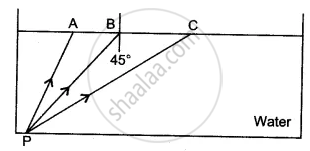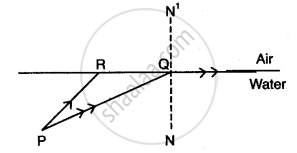Advertisements
Advertisements
Question
In the following figure, show two rays A and B travelling from water to air. If the critical angle for water- air surface is 48°, complete the ray diagram showing the refracted rays for each. State conditions when the ray will suffer total internal reflection.

Solution

The necessary conditions for total internal reflection to occur are
- Light must travel from a denser medium to a rarer medium.
- The angle of incidence must be greater than the critical angle.
In this case, the angle of incidence. ∠ i > 48°
APPEARS IN
RELATED QUESTIONS
State the relation between the critical angle and the absolute refractive index of a medium.
Calculate the speed of light in a medium whose critical angle is 30° ?
(i) Define critical angle.
(ii) State one important factor which affects the critical angle of a given medium.
Write down the relationship between the critical angle and the refractive index of the medium.
The diagram shows a point source P inside a water container. Three rays A, B, and C starting from P are shown up to the water surface. Show in the diagram the path of these rays after striking the water surface. The critical angle for the water-air pair is 48°.

PQ and PR are two light rays emerging from the object as shown in the figure below:

(i) What is the special name given to the angle of incidence (∠PQN) of ray PQ?
(ii) Copy the ray diagram and complete it to show the position of the image of the object P when seen obliquely from above.
(iii) Name the phenomenon that occurs if the angle of incidence ∠PQN is increased still further.
Answer the following question.
Why is prism binoculars preferred over traditional binoculars? Describe its working in brief.
What are the conditions to achieve total internal reflection?
State the condition under which total internal reflection occurs. Give the mathematical expression for total internal reflection.
Which of the following is used in optical fibres?
